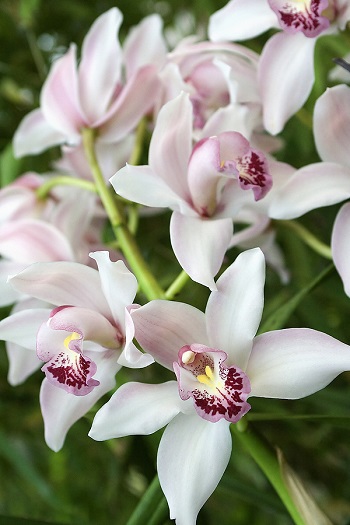
Cymbidiums are said to be the exception to the rule when it comes to orchid care. This is one of the few orchids that can grow freely outside the confinement of greenhouses or homes. In fact, because it thrives so well outdoors, it is a favorite garden plant. It is not choosey about its soil, temperature, and humidity requirements.
To be able to grow them successfully, here are 10 essential rules that you need to follow:
Temperature
Cymbidiums are one of the most enduring orchids when it comes to temperature. They have been observed growing in temperatures ranging from as low as 18°F to as high as 110°F, for a limited time. These species of orchids are best grown outdoors because they can survive virtually any temperature change.
During harsh winters these orchids should be transferred inside if you wish to have them live through the season. Although they could stand the extreme cold for a combined total of two weeks, it could still mean death to them if left outside unattended.
There are certain parts of Florida where these plants refuse to bloom because apparently the night air is a little warmer than they like. Other than that, cymbidiums are the perfect flowers for places with varying temperature.
Light
Since cymbidiums are mostly outdoor orchids, they require a lot of sunlight. During summer they can be exposed to some direct sunlight and still survive. The perfect setting for cymbidiums is under the shade of a larger tree where the sunlight is filtered by the leaves. If you cannot find a place like this, anything that can provide sufficient shade for them during the harsh summer is fine. During winter, these plants need sunlight more than ever so whenever you can, find a spot for them where they can soak in the light for hours at a time.
Soil
Although cymbidiums can grow in almost any soil, these orchids seem to thrive best in leaf mold. Mix equal parts of leaf mold and leaf soil together with a little bit of gravel and you have the perfect soil mixture for cymbidiums. The only medium known not to support cymbidiums is gravel, if you stay away from that, you are fine.
Drainage
An important part and sometimes one of the things that growers forget when cultivating these orchids is the drainage. In their natural habitats, cymbidiums are found to grow in places where there is proper and adequate drainage, so you must recreate this when they are cultivated. A suggested way to do this is by planting them in raised beds, six to twelve inches above the ground. This will ensure that the excess water will naturally exit the soil.
Bedrock
Aside from providing adequate drainage, placing bedrock beneath the soil will also help your cymbidiums with moisture management. Bury them under the ground with less than half of the rock showing. This will make sure that during the summer their root systems stay cool and in winter will help keep them warm by removing excess water.
Fertilizer
When it comes to plant food and cymbidiums, the jury is still out. Most orchid growers who use fertilizers say that feeding a cymbidium will do wonders for it. The only thing that you must be careful not to do is to let the fertilizer touch its pseudobulbs. Because once this happens, they will most likely burn and rot.
You can use either liquid fertilizers or ground manure. Just remember not to overdo it. Twice a year for ground manure and every three months for liquid fertilizer will be enough to provide the nutrients they need.
Water
Compared to other types of orchids, cymbidiums need less water. Cymbidiums that grown outdoors are okay with a watering once or twice every month, even in the summer.
Pots
During winter, where extremely low temperatures are unavoidable, you may want to transfer your cymbidiums into pots. Or if you have chosen to grow them indoors, the task of choosing a container for these types of orchids is equally important.
The perfect pots for cymbidiums are those that can provide proper drainage. Keep them away from shallow pots and fern pans. These containers can easily heat up and can dry the roots. Deep clay pots with a layer of rocks at the bottom are preferable for they are cooler and provide adequate drainage.
Repotting
One of the most crucial steps to growing healthy cymbidiums is repotting. Because they have very delicate root systems they do not respond well to repotting and suffer shock easily. When repotting, make sure that the roots stay intact, or you will not see them bloom for a year or two.
No matter where you decide to grow them, inside or outdoors, cymbidiums are very gracious plants when it comes to flowers. So be sure to keep these essentials in mind. And if you are looking for the least needy plants of all the types of orchids, then cymbidiums are the answer for you.
Mary Ann Berdak is the author of the #1 best seller, Phalaenopsis Orchid Care: The Ultimate Pocket Guide to Moth Orchids, now available at Amazon. For more information on growing healthy orchids, download her free report, “The 5 Biggest Orchid Mistakes (and How to Avoid Them!)”, at OrchidCareZone.com.
Related Articles & Free Email Newsletter Sign Up
Cambria Orchids Offer Beauty and Easy Care
Get to Know Your Orchid Anatomy and Physiology
How to Repot an Orchid in 7 Easy Steps



Comment here